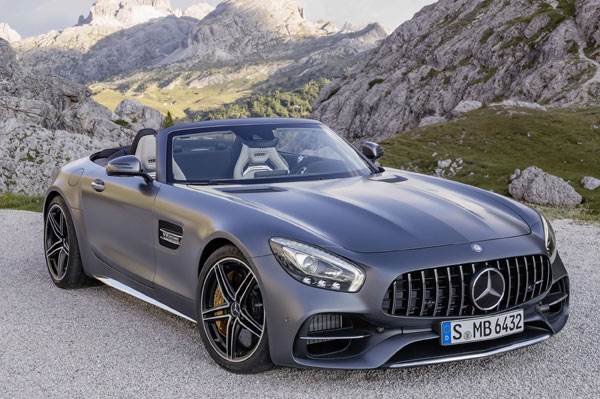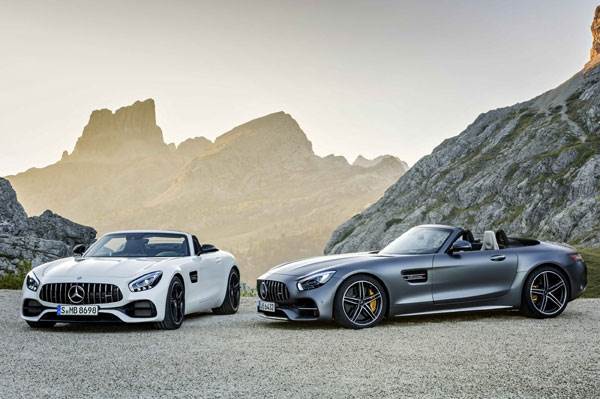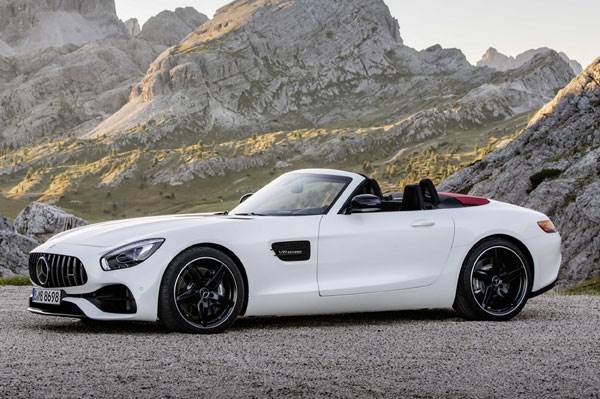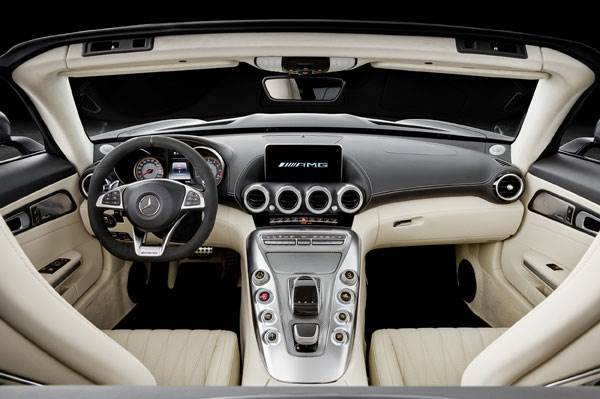The new 316kph Mercedes-AMG GT Roadster has been revealed in a series of official photographs ahead of a planned world premiere for the open-top two seater at the Paris motor show later this month.
Mirroring the strategy taken with the GT Coupé launched in the UK last year, the GT Roadster will be sold in two distinct versions when UK sales get underway later this year: the 475hp GT Roadster and the more comprehensively equipped 555hp GT C Roadster.
Sporting the styling updates unveiled on the 549hp GT R back in June, the GT R Roadster features AMG’s distinctive new 300 SL Panamericana inspired grille, which receives an altered shape and vertical chrome bars instead of the earlier blade treatment seen on the GT Coupé.
To ensure more efficient cooling of the engine and improved aerodynamic properties, the GT Roadster also adopts the active air management system that debuted on the GT R. It uses a series of vertical louvers within the grille, which automatically open and close depending on the temperature of the engine to either enhance cooling or smoothen the airflow. Further visual changes over the GT Coupé include a more defined splitter element in the lower section of the front bumper, larger air ducts and more defined sills underneath the doors.
At the rear, the two GT Roaster models differ in width due to the adoption of differing rear fenders. The standard GT Roadster uses the same fenders as the existing GT Coupé, while the GT C Roadster uses the 57mm wider bodywork of the GT R. This allows the latter to run larger 20-inch rear wheels with 305/30 profile rubber as standard in place of the 19-inch rims and 295/35 tyres of the former.
As with its successor, the SLS Roadster produced between 2011 and 2014, the GT Roadster features an automatic fabric roof. The three layer structure, which comes in black, red or beige, is supported by a frame manufactured from aluminium, magnesium and steel. It opens and closes in a claimed 11sec at speeds up to 50kph, folding and stowing over the rear bulkhead behind the two seat cabin.
Offsetting the loss of a fixed roof structure is a stiffened the aluminium body structure with thicker sill elements, an additional dashboard support and a new aluminium cross member supporting a fixed roll over bars.
Significantly, the GT Roadster packs greater reserves than the GT Coupé to counteract the higher kerb weight brought on by its electrically powered fabric roof and the structural stiffening measures required to accommodate it.
The third model in the GT line-up shares its twin-charged 4.0-litre V8 petrol engine with AMG’s headlining coupé. But while the 90-degree unit delivers 462hp in the GT Coupé and 509hp in the GT S Coupé, its output has risen a respective 13hp and 47hp, giving the GT Roadster 469hp and the GT C Roadster a heady 549hp. Torque is also up, extending by 30Nm in both the GT Roadster and GT C Roadster to 629Nm and 680Nm respectively. By comparison, the twin-turbocharged 3.8-litre horizontally opposed six-cylinder powered Porsche 911 S Turbo Cabriolet kicks out 563.1hp and 700Nm.
Together with the increase in power and torque, the GT Roadster also receives altered gear ratios for its seven-speed Speedshift dual-clutch transaxle. AMG says the new open-top features a higher first and lower seventh gears as well as a lower final drive than the existing GT Coupé.
The rear-wheel drive GT Roadster offers four driving modes as standard via a so-called Dynamic Select controller: Comfort, Sport, Sport Plus and Individual. The more performance focused GT C Roadster adds a fifth mode: Race.
With a power-to-weight ratio of 298.1hp per tonne, the 1,595kg GT Roadster is claimed to hit 100kph in 4.0sec and run to a top speed of 303kph. With 335.5hp per tonne, the more powerful 1,660kg GT C Roadster is claimed to outrun the GT S Coupe to the tune of 0.1sec and 4.82kph with an official 0-100kph time of 3.7sec and 315kph top speed.
AMG explains the 65kg weight difference between the GT Roadster and GT C Roadster due to the latter receiving a higher level of standard features. Included is the rear-wheel steering system first unveiled on the GT R. It steers the rear wheels in the opposite direction to those up front at speeds up to 100kph to enhance agility and reduce the amount of steering input that is required to turn into corners. Once the speed exceeds 100kph, the rear wheels then turn in the same direction as those at the front in a move that is claimed to enhance longitudinal stability without any reduction in overall steering response.
As with the GT Coupé, the two GT Roadster models feature differing suspension setups. The standard GT Roadster model receives a so-called sports suspension with fixed rate damping, with the GT C Roadster boasting AMG Ride Control with adaptive damping.
Although Mercedes-AMG refuses to comment, the German dealer sources confirm the altered styling, more powerful engine and altered gearbox ratios of the GT Roadster models will feature in the facelifted version of the GT Coupé.







Comments
Member Login
Personal Details
No comments yet. Be the first to comment.